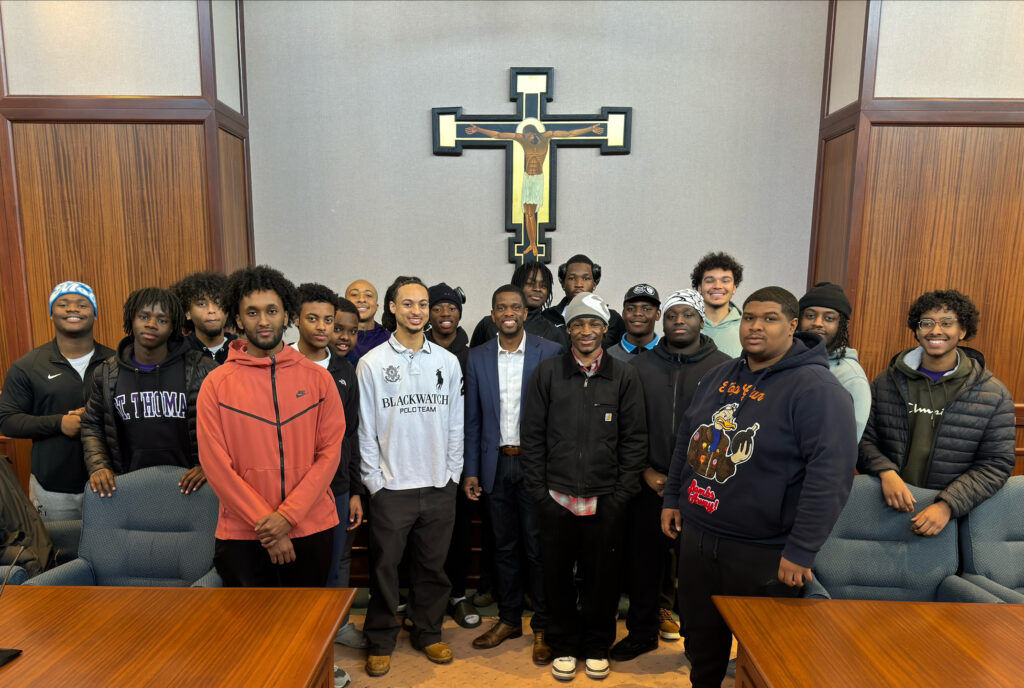OWATONNA – Frank Gehry stood at the podium Sunday afternoon, peered at the crowd of 200, glanced toward the nearby Winton Guest House and announced, “It’s 93.6 percent right.”
The crowd roared, although there might have been some nervous laughter. This was Frank Gehry, after all, one of the world’s most-renowned architects, and he was passing judgment on the move of his famed Winton Guest House from Lake Minnetonka to Owatonna.
“You did an incredible job,” Gehry added. “It is staggering to see it.”
And everybody just breathed easier – a lot easier – because a grade of 93.6 is an A, right?
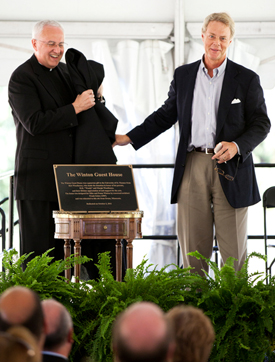
Father Dennis Dease, president of St. Thomas, and Kirt Woodhouse, who donated the Winton Guest House to St. Thomas in 2007, unveil a plaque that honors Woodhouse's parents.
Gehry’s appearance Sunday at the Daniel C. Gainey Conference Center for the dedication of the Winton Guest House capped four years of activity on the project. Other dignitaries on hand included Kirt Woodhouse, who gave the house to St. Thomas, and Penny Winton, who with her late husband, Mike, hired Gehry three decades ago to design the house for their Lake Minnetonka property in Orono.
The 82-year-old Gehry recalled how the Wintons had read a story about him in the New York Times and hired him to build a second house to complement their main home, designed 30 years earlier by Philip Johnson for Minneapolis Institute of Arts curator Richard Davis and his wife.
Gehry joked about how the Wintons “were thinking they wanted a potting shed,” but after extended conversations and a visit to the site, he concluded, “What they really wanted was a sculpture.”
And that is what they got, in the view of architectural historians and critics who raved about the house when it was completed in 1987. It received the first House & Garden magazine Design Award for Architecture and the Award of Honor from the American Institute of Architects, and was included in Time magazine’s “Best of ’87” design section.
The house is composed of six disparate elements unified by a 35-foot-tall, pyramidal-shaped living room finished with black painted metal, as is one bedroom. A second bedroom is covered in limestone, a fireplace room is faced in the same brick as the Johnson house and the garage/kitchenette is covered in Finnish plywood and aluminum strips.
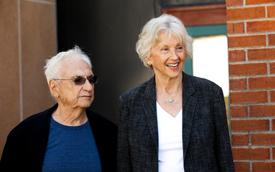
Architect Frank Gehry and Penny Winton, who hired Gehry to design the guest house nearly 30 years ago, chat on Sunday at the Gainey Center.
Woodhouse purchased the Winton estate in 2002, subdivided the property and sold the Johnson-designed house. When the guest house did not attract buyers, he donated it to St. Thomas with the stipulation that the house be moved off the site. St. Thomas chose the Gainey Center.
“I have been afraid to come, as might anyone,” Gehry told the audience, again with tongue in cheek. “I never have had houses of mine moved. I have had them torn down. It is a special treat to have them moved.”
St. Thomas hired Stubbs Building & House Movers. It took nearly two years for Larry Stubbs and his crew to dismantle the house and move its eight pieces 110 miles to Owatonna. Casey & Groesbeck, an Owatonna company, spent a year on reconstruction efforts.
Gehry noted that “Minnesota has been special to me.” He recalled how he assisted as an architect 50 years ago on the design of Southdale shopping center and that the Walker Art Center held a 1986 exhibition on his work. He designed both the original Weisman Art Museum (1993) and its recent expansion, which formally opened Saturday at the University of Minnesota.
“Architecture is about people,” Gehry said. “The treasures of my life.”
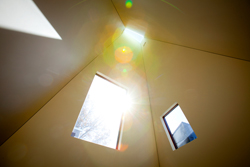
The "living room" of the Winton Guest House includes a 35-foot-tall, pyramidal-shaped space.
After Gehry’s remarks, Woodhouse and Father Dennis Dease, president of St. Thomas, unveiled a plaque that will be placed near the main entrance to the house. The plaque states that Woodhouse made the donation “in honor of his parents, M.K. ‘Woody’ and Margie Woodhouse, and their lifetime appreciation of and support for the arts,” and he told the audience that they had taught more than 100 Elderhostel programs on art and architecture.
Woodhouse also recalled how, after he purchased the Winton property, he took a University of Minnesota course from local architect Jim Dayton to gain a greater understanding of Gehry, who he called “the world’s greatest architect.”
Similar platitudes came from Dr. Victoria Young, a St. Thomas art history professor who served as master of ceremonies on Sunday and curated an exhibit inside the Winton Guest House. She met Gehry when she was a graduate student, standing in a long line after a lecture in New York, and she remembered what he told her that evening: “I guess some day you’ll be writing about me.”
Before the dedication ceremony and a private luncheon in the Gainey Center, Gehry visited Louis Sullivan’s National Farmers Bank in downtown Owatonna. Opened in 1908 and now owned by Wells Fargo, the bank is considered the legendary Sullivan’s masterpiece among the eight “jewel box” banks he designed in the Midwest.
The Winton Guest House will be open to the public for the first time from noon to 4 p.m. Sunday, Oct. 16. There is no cost to attend the event.
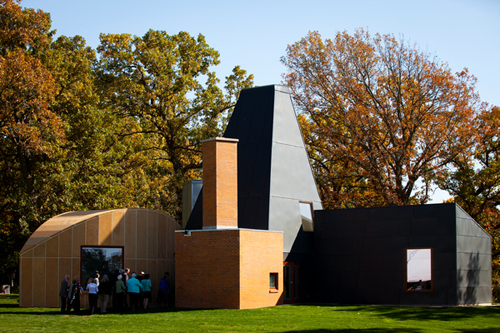
Guests check out the Winton Guest House Sunday at the Gainey Center.



